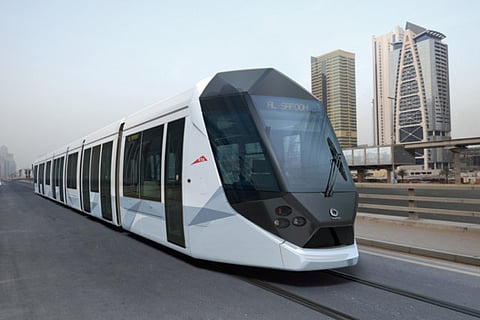Dubai Tram: Zero-danger travelling system to hit the roads next November
Dubai Tram on target to be open in November 2014, 11 stations to be completed by March

Dubai: Dubai Tram, which was earlier called Al Sufouh tramway project, will be the world’s first tram system to have sychronised automatic platform doors as well as automatic train protection and operation system that will assist drivers on board, Gulf News has learnt.
According to a senior Roads and Transport Authority (RTA) official, the high-tech system will ensure high level of safety on platforms as well as on the tracks, ensuring zero danger to passengers or road users.
Dubai Tram will be operational in November 2014.
“This will be the first tram project in the world to have these systems that will make sure the passengers are safe, while it will also ensure that the drivers are alert and punctual. Though the trams are driven by drivers, the system ensures that the trams are on time and doesn’t overshoot any platform,” said Abulredha Abu Al Hassan, Director of Rail Planning and Projects Development at RTA’s Rail Agency.
Phase one of Dubai Tram spans 10.6 kilometres, starting from Dubai Marina and going along Jumeirah Lakes Towers, Dubai Media City, Knowledge Village and Al Sufouh before finishing at the Tram depot next to the Dubai Police Academy.
Eight kilometres of the tram track is at-grade, while 2.6 kilometres within Dubai Marina is elevated on viaduct due to some physical barriers or design requirements.
The phase one will be served by 11 trams and is expected to carry about 27,000 passengers per day at the start of the operations in 2014.
Each tram measures 44 metres in length and has a gold class cabin, two cabins for ladies and children, and four silver class cabins.
The trams have a sixty-member seating capacity, but can accommodate up to 405 passengers.
Revealing details of the stations, currently under construction, for the first time to the media, Al Hassan said. “The stations’ design themes are simple and in harmony with the Metro stations’ design in terms of material and exterior finishes.”
Divided in five types of architectural models, the stations, seven of which are at-grade, will have a clear architectural design with a readily identifiable profile of a public transport facility.
“We have kept it very simple and barrier free, while at the same time we have given utmost importance to safety, the key being the platform screen doors separating the tram carriages from the passengers’ terminal, which is the first in the world with any tram system,” informed Al Hassan.
The tram vehicles’ diamond shape have been designed to reflect the image of Dubai that is known for its trade in gold and precious metal, says Al Hassan.
Measuring 45 metres each, the platform capacity ranges between 260 passengers per lateral platform and maximum of 340 passengers per central platform. Interestingly, unlike in the Dubai Metro, the stations won’t have any Nol card punching gates, instead the Nol scanners will be installed at the entrance and exit of the stations to ensure free movement.
Al Hassan elaborated: “The stations are designed to be open, accessible and barrier-free. The interiors are designed for fast movement of the crowd, so we have not installed any gates inside the station that can slow down the movement, passengers can scan their Nol cards on the go as they move in or out.”
All stations will be serviced with integrated bicycle tracks, footpaths and landscaping as well as bicycles parking facilities, taxi drop off areas. The tram is connected with Palm Jumeirah’s Monorail as well as Dubai Metro at two locations, while the stations are also linked to the bus network all along the route.
Sign up for the Daily Briefing
Get the latest news and updates straight to your inbox


